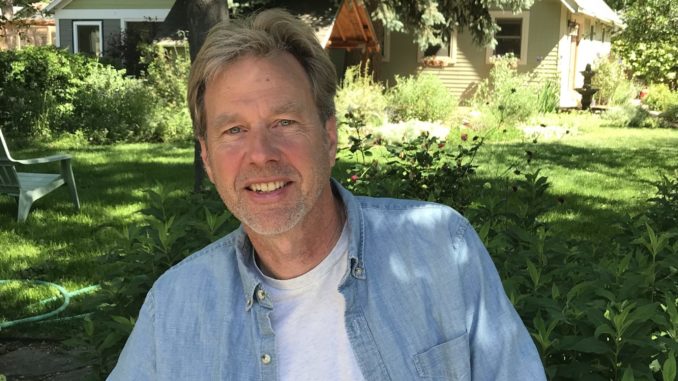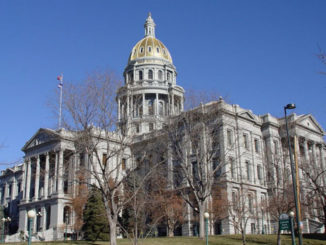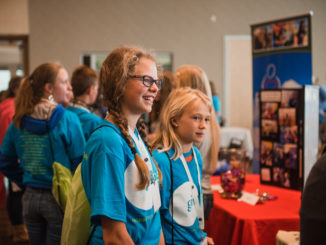
When asked for a definitive statement about Michael Spearnak, her husband of nearly 25 years, Leslie Harms said, “He’s a big man.” Then she smiled and said, “That means he gets bigger portions of food.”
True. He’s well over six feet, though slender and athletic-looking at age 64. But that’s only one of the ways in which Spearnak is “big.” He’s outsize in the way he approaches life, in accomplishments, in attitude and appreciation for those he interacts with, and in his perception of work and play.
He grew up in Leonia, New Jersey, a mile-square bedroom community adjacent to New York City, the third of four boys and with two younger sisters. There were no bars and no movie theaters, but there were some interesting neighbors, like Alan Alda and Gene Shalit. His parents were teachers. A mother who believed in letting her children live their own lives and make their own decisions never told him what he should or should not be doing.
He majored in perceptual psychology at Boston University because to him that seemed like an easy subject to study. He minored in music, something he continues to love to this day. Armed with a degree, he returned to New Jersey, shared a house in Hackensack with several musicians and began writing songs and playing his guitar. To put food on his table, he painted houses.
An acquaintance learned that he had a degree in psychology and suggested he might check into an opening at a local community college. That’s how Spearnak began teaching career counseling. Despite the fact that he had no established career of his own when he began, he took to the work and spent several years coaching people like photographers who wanted to become lawyers and stockbrokers who wanted to do something else.
Then he spent five years teaching impoverished inner city dwellers at an adult learning center in Patterson, New Jersey. His students ranged in age from 16 to 70 and he did everything from GED coaching to teaching basic job skills, ending up as head of the counseling department before burnout caught up with him.
Through conversations with an architect friend, he became intrigued with that line of work, observing that it demanded creativity and was where he could use his talent in sculpture, drawing and math. It took a few years, a marriage and fatherhood before he moved to Colorado, earned residency in the state and enrolled in a thee-year masters program in architecture at the University of Colorado, Denver.
After a stint in private practice, he was hired to manage construction projects for Poudre School District, eventually becoming director of planning, design and construction during a period when several new schools were under construction.
It was in this position that Spearnak’s prior experience in counseling and interest in green, sustainable building coalesced. He was in his element. The result was the construction of local schools that won national and international awards for sustainability and that featured spaces that were practical to maintain and conducive to learning. He was invited to talk about his work across the country and abroad.
“It all started because I didn’t want to get yelled at,” said Spearnak, who tends to be mellow and soft-spoken. “When I asked the head painter for the school district what he thought about our paint choices in a new school, he just said ‘No!’ Then he explained the difficulty of maintaining a dozen colors in schools across the district. I realized that he knew much more about paint choices than we did.”
Spearnak began to work in a new way. He made it a point to consult painters, custodians, groundkeepers—all those who care for buildings—before plans were implemented. His counseling background kicked in as he saw to it that the engineers, architects and management-level people got to know those who maintained the buildings on a personal level. They became a planning team with a wide range of expertise. The result was an integrated approach to design that demanded longer, more inclusive planning sessions and resulted in dramatically better results.
“I’m grateful that I was given the freedom to develop the method,” Spearnak said. He believed in it so strongly that if he had not been able to implement his ideas he would have left his job. He stayed until four years ago. “Then it was time to leave,” he said. “I was ready to do other things.”
He wanted to make music and to explore a long-held interest in radio. “It took me 18 months to get myself down to KRFC and volunteer,” he explained. Today he has a weekly show called The Flip Side, which airs at 6 p.m. on Wednesday nights. On the “A” side, he interviews someone in the community about their musical tastes, and on the “B” side the following week, he plays their favorite music. The “bump” music that introduces the show is his own composition.
These days he finds time to fly fish and to sit on his porch in late afternoon sipping a beer in a lush garden setting created by Leslie, pondering just what may come next in his big life.
Support Northern Colorado Journalism
Show your support for North Forty News by helping us produce more content. It's a kind and simple gesture that will help us continue to bring more content to you.
BONUS - Donors get a link in their receipt to sign up for our once-per-week instant text messaging alert. Get your e-copy of North Forty News the moment it is released!
Click to Donate




This paragraph gives clear idea in favor of the new viewers of blogging, that actually how to
do running a blog.
There’s definately a great deal to find out about this subject.
I really like all the points you made.
You actually make it seem really easy together with your presentation but I
to find this matter to be actually one thing which I feel I would
never understand. It sort of feels too complicated
and extremely large for me. I am taking a look forward
for your next put up, I’ll attempt to get the cling of it!
This article will assist the internet viewers for creating new blog or even a weblog from start to end.
I do trust all of the ideas you have introduced in your post.
They’re really convincing and will definitely
work. Still, the posts are very brief for newbies.
May you please lengthen them a bit from next time?
Thanks for the post.
There’s definately a great deal to find out about this subject.
I really like all the points you made.